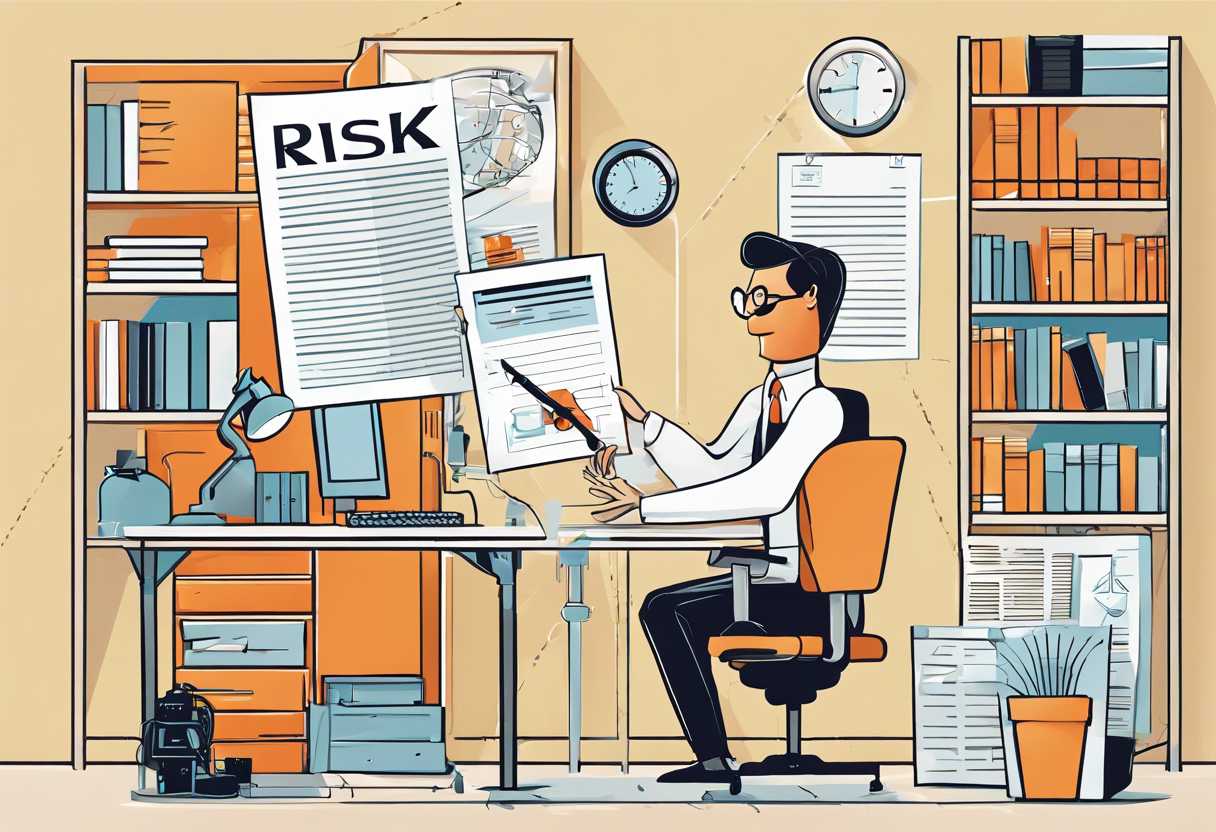Welcome to our comprehensive guide on the risk assessment process. In today’s fast-paced and ever-changing business landscape, understanding and effectively managing risks is crucial for the success and sustainability of any organization. This guide will walk you through the key steps in conducting a comprehensive risk assessment, identifying and analyzing potential risks, and implementing effective risk mitigation strategies. We will also explore the best practices for continuous improvement in risk assessment and management. By the end of this guide, you will have a clear understanding of the importance of risk assessment in business and the tools and strategies needed to navigate potential risks with confidence. So, let’s dive in and explore the essential elements of the risk assessment process.
Understanding the Importance of Risk Assessment in Business
The Role of Risk Assessment in Business
Risk assessment is a crucial process for businesses of all sizes. It involves identifying potential risks that could impact the organization’s operations, finances, or reputation. By conducting a thorough risk assessment, businesses can proactively address potential threats and minimize their impact.
Benefits of Risk Assessment
One of the key benefits of risk assessment is that it allows businesses to make informed decisions. By understanding the potential risks they face, organizations can develop strategies to mitigate these risks and protect their assets. Additionally, risk assessment can help businesses comply with regulations and industry standards, ultimately enhancing their credibility and trustworthiness.
Implementing a Risk Assessment Process
When implementing a risk assessment process, businesses should start by identifying potential risks specific to their industry, operations, and market. This may involve conducting a SWOT analysis, evaluating internal and external factors, and considering historical data. Once risks are identified, they should be prioritized based on their likelihood and potential impact. Businesses can then develop risk management strategies and controls to address these risks effectively.

Key Steps in Conducting a Comprehensive Risk Assessment
Identify Potential Risks
One of the first steps in conducting a comprehensive risk assessment is to identify potential risks that could impact the organization. This involves looking at internal and external factors that could pose a threat to the business, such as financial risks, operational risks, and compliance risks. It’s important to consider all possible scenarios and their potential impact on the organization.
Assess the Likelihood and Impact of Risks
Once potential risks have been identified, the next step is to assess the likelihood and impact of each risk. This involves evaluating the probability of each risk occurring and the potential consequences if it does. By quantifying the likelihood and impact of each risk, organizations can prioritize their response and allocate resources accordingly. This step often involves using a risk matrix to categorize risks based on their likelihood and impact.
Develop Risk Mitigation Strategies
After assessing the likelihood and impact of risks, the next step is to develop risk mitigation strategies to minimize the potential impact of identified risks. This may involve implementing control measures, transferring risk through insurance, or accepting certain risks as part of the business. It’s important to develop a comprehensive plan that addresses each identified risk and outlines specific actions to be taken to mitigate them.

Identifying and Analyzing Potential Risks in the Risk Assessment Process
Common Types of Risks
When conducting a risk assessment, it’s crucial to identify and analyze potential risks that could impact the organization. Common types of risks include financial risks, operational risks, strategic risks, compliance risks, and reputational risks. Financial risks may include market risk, credit risk, and liquidity risk, while operational risks could involve supply chain disruptions, technology failures, or human error. Strategic risks pertain to changes in the business environment, while compliance risks relate to legal and regulatory requirements. Reputational risks can arise from negative publicity or public perception.
Methods for Analyzing Risks
Once potential risks have been identified, it’s essential to analyze them to determine their potential impact and likelihood of occurrence. One method for analyzing risks is the use of a risk matrix, which assesses the severity of a risk based on its likelihood and impact. Another approach is the use of scenario analysis, which involves creating hypothetical situations to understand the potential outcomes of different risks. Additionally, conducting a root cause analysis can help identify the underlying factors contributing to a risk, allowing for targeted mitigation strategies.
| Likelihood | Impact | Severity |
| Low | Low | Low |
| Medium | Medium | Medium |
| High | High | High |
It’s important to note that the analysis of risks should be an ongoing process, as the business environment is constantly evolving. Regular reviews and updates to the risk assessment are necessary to ensure that new risks are identified and existing risks are re-evaluated.
Implementing Effective Risk Mitigation Strategies
The Importance of Risk Mitigation
Risk mitigation is a crucial aspect of any business operation. It involves identifying, assessing, and prioritizing risks, and then taking steps to minimize, control, and monitor the impact of these risks. Effective risk mitigation strategies can help businesses avoid potential financial losses, reputation damage, and operational disruptions.
Key Components of Effective Risk Mitigation Strategies
When implementing risk mitigation strategies, it’s important to consider several key components. First, businesses should conduct a thorough risk assessment to identify potential threats and vulnerabilities. This assessment should include an analysis of internal and external factors that could impact the organization. Once risks are identified, businesses should prioritize them based on their potential impact and likelihood of occurrence. After prioritization, businesses can develop and implement specific mitigation measures to address each identified risk.
- Thorough risk assessment
- Prioritization of risks
- Development and implementation of mitigation measures
Best Practices for Implementing Risk Mitigation Strategies
Implementing effective risk mitigation strategies requires a proactive and comprehensive approach. Businesses should regularly review and update their risk management plans to ensure they remain relevant and effective. Additionally, it’s important to involve key stakeholders in the risk mitigation process to gain diverse perspectives and expertise. Finally, businesses should consider leveraging technology and data analytics to enhance their risk mitigation efforts.
- Regular review and update of risk management plans
- Involvement of key stakeholders in the risk mitigation process
- Leveraging technology and data analytics
Best Practices for Continuous Improvement in Risk Assessment and Management
Utilizing Data-Driven Approaches
One of the best practices for continuous improvement in risk assessment and management is to utilize data-driven approaches. By collecting and analyzing relevant data, organizations can gain valuable insights into potential risks and develop effective strategies for mitigating them. This can involve leveraging advanced analytics tools to identify patterns and trends, as well as conducting thorough risk assessments based on historical data and industry benchmarks.
Implementing Robust Risk Management Frameworks
Another key aspect of continuous improvement in risk assessment and management is the implementation of robust risk management frameworks. This involves establishing clear policies and procedures for identifying, assessing, and responding to risks, as well as regularly reviewing and updating these frameworks to ensure they remain effective in the face of evolving threats. By integrating risk management into the organization’s overall governance structure, companies can proactively address potential risks and minimize their impact on operations.
Emphasizing Collaboration and Communication
Effective risk assessment and management also rely on strong collaboration and communication across different departments and levels of the organization. By fostering a culture of transparency and accountability, companies can ensure that relevant stakeholders are involved in the risk management process and are equipped to contribute their expertise and insights. This can involve regular meetings and reporting mechanisms to keep everyone informed about potential risks and the strategies in place to address them.
Conclusion
As we conclude this comprehensive guide to the risk assessment process, it is evident that understanding the importance of risk assessment in business is crucial for long-term success. By following the key steps in conducting a comprehensive risk assessment, businesses can identify and analyze potential risks, allowing them to implement effective risk mitigation strategies.
It is essential for organizations to continuously improve their risk assessment and management practices by adopting best practices. This includes staying updated with industry trends, leveraging technology, and fostering a culture of risk awareness and proactive decision-making.
Ultimately, a well-executed risk assessment process can help businesses anticipate and navigate potential challenges, leading to better decision-making and sustainable growth. We encourage you to apply the insights shared in this guide to enhance your risk assessment practices and drive positive outcomes for your organization.
Thank you for reading our complete guide to the risk assessment process. If you have any questions or need further assistance, feel free to reach out to our team of experts. Here’s to effective risk assessment and successful risk management!

